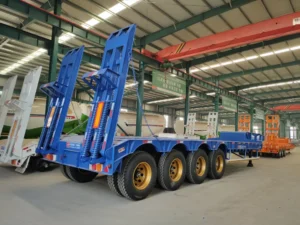Introduction:
Semi-trailers play a pivotal role in the transportation industry, efficiently moving goods across vast distances. These large commercial vehicles are a common sight on highways and roads, but have you ever wondered about the specific dimensions of a semi-trailer? Such as how long is a semi trailer? In this article, we will delve into the various aspects of semi-trailer dimensions and the significance of adhering to regulations governing their size.
Standard Semi-Trailer Dimensions
The length of a semi-trailer can vary depending on regional regulations and the specific type of trailer used. However, in the United States, the standard dimensions for a semi-trailer are as follows:
-
Length
In general, the length of a semi-trailer ranges from 48 feet to 53 feet. The most common length is 53 feet, which is widely used for interstate trucking. Some states restrict the maximum length to 48 feet, especially in urban areas or on certain roadways.
-
Width
The standard width of a semi-trailer is 8.5 feet. This width is the same as most commercial vehicles and adheres to road safety standards.
-
Height
The typical height of a semi-trailer ranges from 13.5 to 14 feet. This dimension allows enough space for cargo while ensuring the vehicle can pass under bridges and other structures.
-
Weight
The maximum weight of a loaded semi-trailer is regulated to prevent damage to roads and bridges. In the U.S., the federal maximum weight limit for a semi-trailer, including cargo, is 80,000 pounds.
Variations in Semi-Trailer Types
While the dimensions mentioned above apply to standard dry van semi-trailers, it’s important to note that there are various other types of trailers designed to suit specific transportation needs:
Flatbed Trailers:

Flatbed trailers have no sides or roof, making them suitable for carrying large or irregularly shaped cargo. They share similar dimensions with dry van trailers.
Refrigerated Trailers (Reefers):
Reefers are used for transporting perishable goods, requiring climate control. They have similar dimensions to dry van trailers but are equipped with cooling systems.
Lowboy Trailers:

Lowboy trailers are designed to transport oversized or tall cargo, such as heavy machinery or construction equipment. Their height is usually lower, allowing for taller cargo without exceeding height restrictions.
Tanker Trailers:

Tanker trailers carry liquids or gases, such as fuel, chemicals, or food products. They have a cylindrical shape and are often shorter in length compared to dry van trailers.
Regulations and Safety Considerations
Semi-trailers are essential for the efficient movement of goods, but they must adhere to strict regulations to ensure safety on the roads. Governments set these regulations to prevent accidents, minimize road wear, and manage traffic flow effectively. Overloaded or improperly sized trailers can lead to increased risk on the roads, making adherence to regulations crucial.
In the United States, the Federal Motor Carrier Safety Administration (FMCSA) oversees the regulations for semi-trailers, including weight limits, length restrictions, and other safety measures. State authorities may also impose additional rules, depending on local conditions and infrastructure.
Length Restrictions for Semi-Trailers in Asian Countries
The transportation industry in Asian countries, especially in countries like China, heavily relies on semi-trailers to efficiently move goods across vast distances. However, as road safety and infrastructure concerns arise, regulations governing the dimensions of semi-trailers become critical. In this article, we will explore the specific length restrictions for semi-trailers in China and how these regulations impact the logistics landscape.
Regulatory Landscape in China
China, known for its extensive road network and thriving commercial activities, has stringent regulations in place to govern the operation of semi-trailers. The relevant government authorities have implemented these restrictions to maintain road safety, preserve infrastructure, and optimize traffic flow. The primary regulatory body overseeing transportation in China is the Ministry of Transport.
Reasons for Length Restrictions on Semi-Trailers
In most Asian countries the transportation industry forms the backbone of the thriving economy. To ensure the safe and efficient movement of goods, length restrictions for semi-trailers have been established, particularly in Asia, where the road network is extensive. These regulations help maintain road safety, protect infrastructure, and optimize traffic flow.
As the transportation industry continues to evolve, it is essential for logistics companies and truck operators to stay updated with the latest regulations to comply with the law while contributing to the seamless functioning of the supply chain in this dynamic and ever-expanding region.
It’s essential to note that there might be some variations in length restrictions depending on the type of semi-trailer and the specific country and region. In countries like China and India, where the population is too high, maintaining traffic can be very complicated, especially during working hours. In such countries and densely populated metropolitan areas, the length restrictions might be even stricter to avoid traffic congestion.
Length of Semi-Trailer and Its Impact on the Transportation Industry
How long is a standard semi trailer? The length restrictions for semi-trailers in rapidly developing Asian countries like China and India have several implications for the transportation industry:
-
Cargo Capacity:
The length of a semi-trailer significantly impacts its cargo-carrying capacity. With the 16.5-meter limitation, logistics companies must carefully plan and optimize the use of available space to transport goods efficiently.
-
Compliance Costs:
Ensuring compliance with length regulations may necessitate the adoption of specialized trailer designs or adjustments to existing equipment. This can lead to increased costs for logistics companies and truck operators.
-
Road Safety:
Length restrictions play a crucial role in maintaining road safety. Limiting the length of semi-trailers helps prevent accidents and ensures that vehicles can navigate roads and intersections without obstructing traffic flow.
-
Infrastructure Maintenance:
By restricting semi-trailer length, authorities aim to reduce wear and tear on roads and bridges, ultimately reducing the burden on infrastructure maintenance.
-
Urban Traffic Management:
In densely populated urban areas, stricter length restrictions may be in place to mitigate traffic congestion and accommodate narrower streets.
Compliance and Enforcement
Enforcement of length restrictions for semi-trailers is a joint responsibility shared by the Ministry of Transport, local transportation authorities, and law enforcement agencies. Routine inspections, weigh stations, and surveillance cameras are used to monitor compliance with these regulations. Violations may lead to penalties, fines, or temporary suspensions of the offending vehicle’s operation.
Conclusion:
Semi-trailers are indispensable for transporting goods across vast distances, enabling the global supply chain to function efficiently. While the standard dimensions of a semi-trailer are approximately 53 feet in length, variations exist depending on the specific trailer type and regional regulations. Adherence to safety standards and regulations is critical to ensuring the smooth and secure operation of these vital commercial vehicles on our roads.
Next time you see a semi-trailer on the highway, you can appreciate the thoughtfulness that goes into its design and adherence to regulations, making it an indispensable component of modern logistics and commerce.
